Heme A Synthase Deficiency Affects the Ability of Bacillus cereus to Adapt to a Nutrient-Limited Environment
Abstract
1. Introduction
2. Results
2.1. B. cereus AH187 CtaA Is Required for Cytochrome Aa3 Oxidase Activity, and Optimal Growth
2.2. Proteome and Exoproteome Response to CtaA Deficiency
2.2.1. Cellular Proteome
2.2.2. Exoproteome Analysis
2.3. Phenotypic Characterization of CtaA-Deficient B. cereus AH187 Strain
2.3.1. Resistance to Stress
2.3.2. Motility
2.3.3. Surface Properties
2.3.4. Adhesion/Biofilm
2.3.5. Sporulation
3. Discussion
4. Materials and Methods
4.1. Bacterial Strain and Mutant Construction
4.2. Growth Parameters and Analytical Procedures
4.3. TMPD Oxidase Staining
4.4. Sample Preparation for Shotgun Proteomics
4.5. Protein Identification by LC–MS/MS and Label-Free Quantification
4.6. S-Layer Extraction and Western Blot Analysis
4.7. Cell Survival at 4 °C
4.8. Hydrogen Peroxide Killing Assays
4.9. Autoaggregation
4.10. Motility
4.11. Bacterial Adhesion (BioFilm Ring Test®)
4.12. Statistical Analyses
Supplementary Materials
Author Contributions
Funding
Informed Consent Statement
Data Availability Statement
Acknowledgments
Conflicts of Interest
References
- Jovanovic, J.; Ornelis, V.F.M.; Madder, A.; Rajkovic, A. Bacillus cereus food intoxication and toxicoinfection. Compr. Rev. Food Sci. Food Saf. 2021, 20, 3719–3761. [Google Scholar] [CrossRef] [PubMed]
- Rousset, L.; Alpha-Bazin, B.; Château, A.; Armengaud, J.; Clavel, T.; Berge, O.; Duport, C. Groundwater promotes emergence of asporogenic mutants of emetic Bacillus cereus. Environ. Microbiol. 2020, 22, 5248–5264. [Google Scholar] [CrossRef] [PubMed]
- Mueller, J.P.; Taber, H.W. Isolation and sequence of ctaA, a gene required for cytochrome aa3 biosynthesis and sporulation in Bacillus subtilis. J. Bacteriol. 1989, 171, 4967–4978. [Google Scholar] [CrossRef] [PubMed]
- Han, H.; Sullivan, T.; Wilson, A.C. Cytochrome C551 and the Cytochrome c Maturation Pathway Affect Virulence Gene Expression in Bacillus cereus ATCC 14579. J. Bacteriol. 2015, 197, 626–635. [Google Scholar] [CrossRef] [PubMed]
- Sousa, P.M.; Videira, M.A.; Santos, F.A.; Hood, B.L.; Conrads, T.P.; Melo, A.M. The bc:caa3 supercomplexes from the Gram positive bacterium Bacillus subtilis respiratory chain: A megacomplex organization? Arch. Biochem. Biophys. 2013, 537, 153–160. [Google Scholar] [CrossRef]
- Rosenfeld, E.; Duport, C.; Zigha, A.; Schmitt, P. Characterization of aerobic and anaerobic vegetative growth of the food-borne pathogen Bacillus cereus F4430/73 strain. Can. J. Microbiol. 2005, 51, 149–158. [Google Scholar] [CrossRef] [PubMed]
- Duport, C.; Jobin, M.; Schmitt, P. Adaptation in Bacillus cereus: From Stress to Disease. Front. Microbiol. 2016, 7, 1550. [Google Scholar] [CrossRef] [PubMed]
- Contreras-Zentella, M.; Mendoza, G.; Membrillo-Hernández, J.; Escamilla, J.E. A Novel Double Heme Substitution Produces a Functional Bo3 Variant of the Quinol Oxidase Aa3 of Bacillus cereus. Purification and Paratial Characterization. J. Biol. Chem. 2003, 278, 31473–31478. [Google Scholar] [CrossRef]
- Borisov, V.B.; Siletsky, S.A.; Paiardini, A.; Hoogewijs, D.; Forte, E.; Giuffrè, A.; Poole, R.K. Bacterial Oxidases of the Cytochrome bd Family: Redox Enzymes of Unique Structure, Function, and Utility As Drug Targets. Antioxid. Redox Signal. 2021, 34, 1280–1318. [Google Scholar] [CrossRef] [PubMed]
- von Wachenfeldt, C.; Hederstedt, L. Molecular biology of Bacillus subtilis cytochromes. FEMS Microbiol. Lett. 1992, 100, 91–100. [Google Scholar] [CrossRef][Green Version]
- Hederstedt, L. Molecular Biology of Bacillus subtilis Cytochromes anno 2020. Biochemistry 2021, 86, 8–21. [Google Scholar] [CrossRef]
- Larsson, J.T.; Rogstam, A.; Von Wachenfeldt, C. Coordinated patterns of cytochrome bd and lactate dehydrogenase expression in Bacillus subtilis. Microbiology 2005, 151, 3323–3335. [Google Scholar] [CrossRef]
- Van der Oost, J.; von Wachenfeld, C.; Hederstedt, L.; Saraste, M. Bacillus subtilis chytochrome oxidase mutants: Biochemical analysis and genetic evidence for two aa3-type oxidases. Mol. Microbiol. 1991, 5, 2063–2072. [Google Scholar] [CrossRef]
- Emadeira, J.-P.; Alpha-Bazin, B.; Armengaud, J.; Eduport, C. Time dynamics of the Bacillus cereus exoproteome are shaped by cellular oxidation. Front. Microbiol. 2015, 6, 342. [Google Scholar] [CrossRef]
- Terol, G.L.; Gallego-Jara, J.; Martínez, R.A.S.; Díaz, M.C.; Puente, T.D.D. Engineering protein production by rationally choosing a carbon and nitrogen source using E. coli BL21 acetate metabolism knockout strains. Microb. Cell Factories 2019, 18, 151. [Google Scholar] [CrossRef] [PubMed]
- Lanciano, P.; Khalfaoui-Hassani, B.; Selamoglu, N.; Ghelli, A.; Rugolo, M.; Daldal, F. Molecular mechanisms of superoxide production by complex III: A bacterial versus human mitochondrial comparative case study. Biochim. Biophys. Acta 2013, 1827, 1332–1339. [Google Scholar] [CrossRef]
- Marquis, R.E. Nature of the Bactericidal Action of Antimycin A for Bacillus megaterium. J. Bacteriol. 1965, 89, 1453–1459. [Google Scholar] [CrossRef] [PubMed]
- Kim, M.I.; Lee, C.; Park, J.; Jeon, B.-Y.; Hong, M. Crystal structure of Bacillus cereus flagellin and structure-guided fusion-protein designs. Sci. Rep. 2018, 8, 5814. [Google Scholar] [CrossRef]
- Tanner, A.W.; Carabetta, V.J.; Martinie, R.; Mashruwala, A.A.; Boyd, J.; Krebs, C.; Dubnau, D. The RicAFT (YmcA-YlbF-YaaT) complex carries two [4Fe-4S] 2+ clusters and may respond to redox changes. Mol. Microbiol. 2017, 104, 837–850. [Google Scholar] [CrossRef]
- Carabetta, V.J.; Tanner, A.W.; Greco, T.M.; DeFrancesco, M.; Cristea, I.M.; Dubnau, D. A complex of YlbF, YmcA and YaaT regulates sporulation, competence and biofilm formation by accelerating the phosphorylation of Spo0A. Mol. Microbiol. 2013, 88, 283–300. [Google Scholar] [CrossRef] [PubMed]
- Adusei-Danso, F.; Khaja, F.T.; DeSantis, M.; Jeffrey, P.D.; Dubnau, E.; Demeler, B.; Neiditch, M.; Dubnau, D. Structure-Function Studies of the Bacillus subtilis Ric Proteins Identify the Fe-S Cluster-Ligating Residues and Their Roles in Development and RNA Processing. mBio 2019, 10, e01841-19. [Google Scholar] [CrossRef]
- Cendrowski, S.; MacArthur, W.; Hanna, P. Bacillus anthracis requires siderophore biosynthesis for growth in macrophages and mouse virulence. Mol. Microbiol. 2004, 51, 407–417. [Google Scholar] [CrossRef] [PubMed]
- Miethke, M.; Klotz, O.; Linne, U.; May, J.J.; Beckering, C.L.; Marahiel, M.A. Ferri-bacillibactin uptake and hydrolysis in Bacillus subtilis. Mol. Microbiol. 2006, 61, 1413–1427. [Google Scholar] [CrossRef]
- Zawadzka, A.M.; Abergel, R.J.; Nichiporuk, R.; Andersen, U.N.; Raymond, K.N. Siderophore-Mediated Iron Acquisition Systems in Bacillus cereus: Identification of Receptors for Anthrax Virulence-Associated Petrobactin. Biochemistry 2009, 48, 3645–3657. [Google Scholar] [CrossRef]
- Daou, N.; Buisson, C.; Gohar, M.; Vidic, J.; Bierne, H.; Kallassy, M.; Lereclus, D.; Nielsen-Leroux, C. IlsA, A Unique Surface Protein of Bacillus cereus Required for Iron Acquisition from Heme, Hemoglobin and Ferritin. PLoS Pathog. 2009, 5, e1000675. [Google Scholar] [CrossRef] [PubMed]
- Tu, W.Y.; Pohl, S.; Gizynski, K.; Harwood, C.R. The Iron-Binding Protein Dps2 Confers Peroxide Stress Resistance on Bacillus anthracis. J. Bacteriol. 2012, 194, 925–931. [Google Scholar] [CrossRef]
- Touati, D. Iron and Oxidative Stress in Bacteria. Arch. Biochem. Biophys. 2000, 373, 1–6. [Google Scholar] [CrossRef]
- Valiauga, B.; Williams, E.M.; Ackerley, D.F.; Čėnas, N. Reduction of quinones and nitroaromatic compounds by Escherichia coli nitroreductase A (NfsA): Characterization of kinetics and substrate specificity. Arch. Biochem. Biophys. 2017, 614, 14–22. [Google Scholar] [CrossRef]
- Li, T.; Zhao, Z.; Wang, Q.; Xie, P.; Ma, J. Strongly enhanced Fenton degradation of organic pollutants by cysteine: An aliphatic amino acid accelerator outweighs hydroquinone analogues. Water Res. 2016, 105, 479–486. [Google Scholar] [CrossRef]
- Erlendsson, L.S.; Möller, M.; Hederstedt, L. Bacillus subtilis StoA Is a Thiol-Disulfide Oxidoreductase Important for Spore Cortex Synthesis. J. Bacteriol. 2004, 186, 6230–6238. [Google Scholar] [CrossRef] [PubMed]
- Möller, M.C.; Hederstedt, L. Role of Membrane-Bound Thiol–Disulfide Oxidoreductases in Endospore-Forming Bacteria. Antioxid. Redox Signal. 2006, 8, 823–833. [Google Scholar] [CrossRef] [PubMed]
- Moore, C.M.; Nakano, M.M.; Wang, T.; Ye, R.W.; Helmann, J.D. Response of Bacillus subtilis to Nitric Oxide and the Nitrosating Agent Sodium Nitroprusside. J. Bacteriol. 2004, 186, 4655–4664. [Google Scholar] [CrossRef] [PubMed]
- Nakano, M.M.; Geng, H.; Nakano, S.; Kobayashi, K. The Nitric Oxide-Responsive Regulator NsrR Controls ResDE-Dependent Gene Expression. J. Bacteriol. 2006, 188, 5878–5887. [Google Scholar] [CrossRef] [PubMed]
- Hatzios, S.; Bertozzi, C.R. The Regulation of Sulfur Metabolism in Mycobacterium tuberculosis. PLoS Pathog. 2011, 7, e1002036. [Google Scholar] [CrossRef]
- Riboldi, G.P.; Bierhals, C.G.; De Mattos, E.P.; Frazzon, A.P.G.; D’Azevedo, P.A.; Frazzon, J. Oxidative stress enhances the expression of sulfur assimilation genes: Preliminary insights on the Enterococcus faecalis iron-sulfur cluster machinery regulation. Mem. Inst. Oswaldo Cruz 2014, 109, 408–413. [Google Scholar] [CrossRef]
- Das, M.; Dewan, A.; Shee, S.; Singh, A. The Multifaceted Bacterial Cysteine Desulfurases: From Metabolism to Pathogenesis. Antioxidants 2021, 10, 997. [Google Scholar] [CrossRef] [PubMed]
- Park, S.; Imlay, J.A. High Levels of Intracellular Cysteine Promote Oxidative DNA Damage by Driving the Fenton Reaction. J. Bacteriol. 2003, 185, 1942–1950. [Google Scholar] [CrossRef] [PubMed]
- Lyngberg, L.; Healy, J.; Bartlett, W.; Miller, S.; Conway, S.J.; Booth, I.R.; Rasmussen, T. KefF, the Regulatory Subunit of the Potassium Efflux System KefC, Shows Quinone Oxidoreductase Activity. J. Bacteriol. 2011, 193, 4925–4932. [Google Scholar] [CrossRef] [PubMed]
- Bendtsen, J.D.; Kiemer, L.; Fausbøll, A.; Brunak, S. Non-classical protein secretion in bacteria. BMC Microbiol. 2005, 5, 58. [Google Scholar] [CrossRef]
- Carlin, F.; Albagnac, C.; Rida, A.; Guinebretière, M.-H.; Couvert, O.; Nguyen-The, C. Variation of cardinal growth parameters and growth limits according to phylogenetic affiliation in the Bacillus cereus Group. Consequences for risk assessment. Food Microbiol. 2013, 33, 69–76. [Google Scholar] [CrossRef] [PubMed]
- Trunk, T.; Khalil, H.S.; Leo, J.C. Bacterial autoaggregation. AIMS Microbiol. 2018, 4, 140–164. [Google Scholar] [CrossRef]
- Dienerowitz, M.; Cowan, L.V.; Gibson, G.M.; Hay, R.; Padgett, M.J.; Phoenix, V.R. Optically trapped bacteria pairs reveal discrete motile response to control aggregation upon cell-cell approach. Curr. Microbiol. 2014, 69, 669–674. [Google Scholar] [CrossRef] [PubMed]
- Sulaeman, S.; Le Bihan, G.; Rossero, A.; Federighi, M.; Dé, E.; Tresse, O. Comparison between the biofilm initiation of Campylobacter jejuni and Campylobacter colistrains to an inert surface using BioFilm Ring Test®. J. Appl. Microbiol. 2010, 108, 1303–1312. [Google Scholar] [CrossRef] [PubMed]
- Sorroche, F.G.; Spesia, M.; Zorreguieta, A.; Giordano, W. A Positive Correlation between Bacterial Autoaggregation and Biofilm Formation in Native Sinorhizobium meliloti Isolates from Argentina. Appl. Environ. Microbiol. 2012, 78, 4092–4101. [Google Scholar] [CrossRef] [PubMed]
- Setlow, P. Spore Resistance Properties. Microbiol. Spectr. 2014, 2, 201–215. [Google Scholar] [CrossRef]
- Caro-Astorga, J.; Frenzel, E.; Perkins, J.R.; Álvarez-Mena, A.; De Vicente, A.; Ranea, J.A.G.; Kuipers, O.P.; Romero, D. Biofilm formation displays intrinsic offensive and defensive features of Bacillus cereus. NPJ Biofilms Microbiomes 2020, 6, 3. [Google Scholar] [CrossRef]
- Morens, D.M.; Fauci, A.S. Emerging Infectious Diseases: Threats to Human Health and Global Stability. PLoS Pathog. 2013, 9, e1003467. [Google Scholar] [CrossRef] [PubMed]
- Cao, H.; Plague, G.R. The fitness effects of a point mutation in Escherichia coli change with founding population density. Genetica 2016, 144, 417–424. [Google Scholar] [CrossRef]
- Chaudhari, S.S.; Kim, M.; Lei, S.; Razvi, F.; Alqarzaee, A.A.; Hutfless, E.H.; Powers, R.; Zimmerman, M.C.; Fey, P.D.; Thomas, V.C. Nitrite Derived from Endogenous Bacterial Nitric Oxide Synthase Activity Promotes Aerobic Respiration. mBio 2017, 8, e00887-17. [Google Scholar] [CrossRef] [PubMed]
- Vinogradov, A.D.; Grivennikova, V.G. Oxidation of NADH and ROS production by respiratory complex I. Biochim. Biophys. Acta 2016, 1857, 863–871. [Google Scholar] [CrossRef]
- Larosa, V.; Remacle, C. Insights into the respiratory chain and oxidative stress. Biosci. Rep. 2018, 38. [Google Scholar] [CrossRef]
- Mols, M.; Abee, T. Primary and secondary oxidative stress in Bacillus. Environ. Microbiol. 2011, 13, 1387–1394. [Google Scholar] [CrossRef]
- Clements, M.O.; Watson, S.P.; Poole, R.K.; Foster, S.J. CtaA of Staphylococcus aureus Is Required for Starvation Survival, Recovery, and Cytochrome Biosynthesis. J. Bacteriol. 1999, 181, 501–507. [Google Scholar] [CrossRef] [PubMed]
- Greninger, A.L.; Addetia, A.; Tao, Y.; Adler, A.; Qin, X. Inactivation of genes in oxidative respiration and iron acquisition pathways in pediatric clinical isolates of Small colony variant Enterobacteriaceae. Sci. Rep. 2021, 11, 7457. [Google Scholar] [CrossRef]
- Del Arenal, I.P.; Contreras, M.L.; Svlateorova, B.B.; Rangel, P.; Lledías, F.; Dávila, J.R.; Escamilla, J.E. Haem O and a putative cytochrome bo in a mutant of Bacillus cereus impaired in the synthesis of haem A. Arch. Microbiol. 1997, 167, 24–31. [Google Scholar] [CrossRef] [PubMed]
- Szenk, M.; Dill, K.A.; de Graff, A.M. Why Do Fast-Growing Bacteria Enter Overflow Metabolism? Testing the Membrane Real Estate Hypothesis. Cell Syst. 2017, 5, 95–104. [Google Scholar] [CrossRef]
- Millard, P.; Enjalbert, B.; Uttenweiler-Joseph, S.; Portais, J.-C.; Létisse, F. Control and regulation of acetate overflow in Escherichia coli. eLife 2021, 10, e63661. [Google Scholar] [CrossRef] [PubMed]
- Rabbers, I.; Gottstein, W.; Feist, A.; Teusink, B.; Bruggeman, F.J.; Bachmann, H. Selection for Cell Yield Does Not Reduce Overflow Metabolism in E. Coli. Mol. Biol. Evol. 2021, msab345. [Google Scholar] [CrossRef]
- Giuliodori, A.M.; Gualerzi, C.O.; Soto, S.M.; Vilá, J.; Tavío, M.M. Review on Bacterial Stress Topics. Ann. N. Y. Acad. Sci. 2007, 1113, 95–104. [Google Scholar] [CrossRef]
- Sleytr, U.B.; Messner, P.; Pum, D.; Sára, M. Crystalline bacterial cell surface layers. Mol. Microbiol. 1993, 10, 911–916. [Google Scholar] [CrossRef]
- Liu, C.-C.; Lin, M.-H. Involvement of Heme in Colony Spreading of Staphylococcus aureus. Front. Microbiol. 2020, 11, 170. [Google Scholar] [CrossRef] [PubMed]
- Hecker, M.; Völker, U. General stress response of Bacillus subtilis and other bacteria. Adv. Microb. Physiol. 2001, 44, 35–91. [Google Scholar] [CrossRef] [PubMed]
- Nwoko, E.-S.Q.A.; Okeke, I.N. Bacteria autoaggregation: How and why bacteria stick together. Biochem. Soc. Trans. 2021, 49, 1147–1157. [Google Scholar] [CrossRef]
- Ehling-Schulz, M.; Svensson, B.; Guinebretiere, M.-H.; Lindbäck, T.; Andersson, M.; Schulz, A.; Fricker, M.; Christiansson, A.; Granum, P.E.; Märtlbauer, E.; et al. Emetic toxin formation of Bacillus cereus is restricted to a single evolutionary lineage of closely related strains. Microbiology 2005, 151, 183–197. [Google Scholar] [CrossRef]
- Arnaud, M.; Chastanet, A.; Débarbouillé, M. New Vector for Efficient Allelic Replacement in Naturally Nontransformable, Low-GC-Content, Gram-Positive Bacteria. Appl. Environ. Microbiol. 2004, 70, 6887–6891. [Google Scholar] [CrossRef]
- Zwietering, M.H.; Jongenburger, I.; Rombouts, F.M.; Van’t Riet, K. Modeling of the Bacterial Growth Curve. Appl. Environ. Microbiol. 1990, 56, 1875–1881. [Google Scholar] [CrossRef]
- Christie-Oleza, J.A.; Fernandez, B.; Nogales, B.; Bosch, R.; Armengaud, J. Proteomic insights into the lifestyle of an environmentally relevant marine bacterium. ISME J. 2012, 6, 124–135. [Google Scholar] [CrossRef] [PubMed]
- Zhang, X.; Smits, A.H.; Van Tilburg, G.B.; Ovaa, H.; Huber, W.; Vermeulen, M. Proteome-wide identification of ubiquitin interactions using UbIA-MS. Nat. Protoc. 2018, 13, 530–550. [Google Scholar] [CrossRef] [PubMed]
- Nguyen-Mau, S.-M.; Oh, S.-Y.; Kern, V.J.; Missiakas, D.M.; Schneewind, O. Secretion Genes as Determinants of Bacillus anthracis Chain Length. J. Bacteriol. 2012, 194, 3841–3850. [Google Scholar] [CrossRef][Green Version]
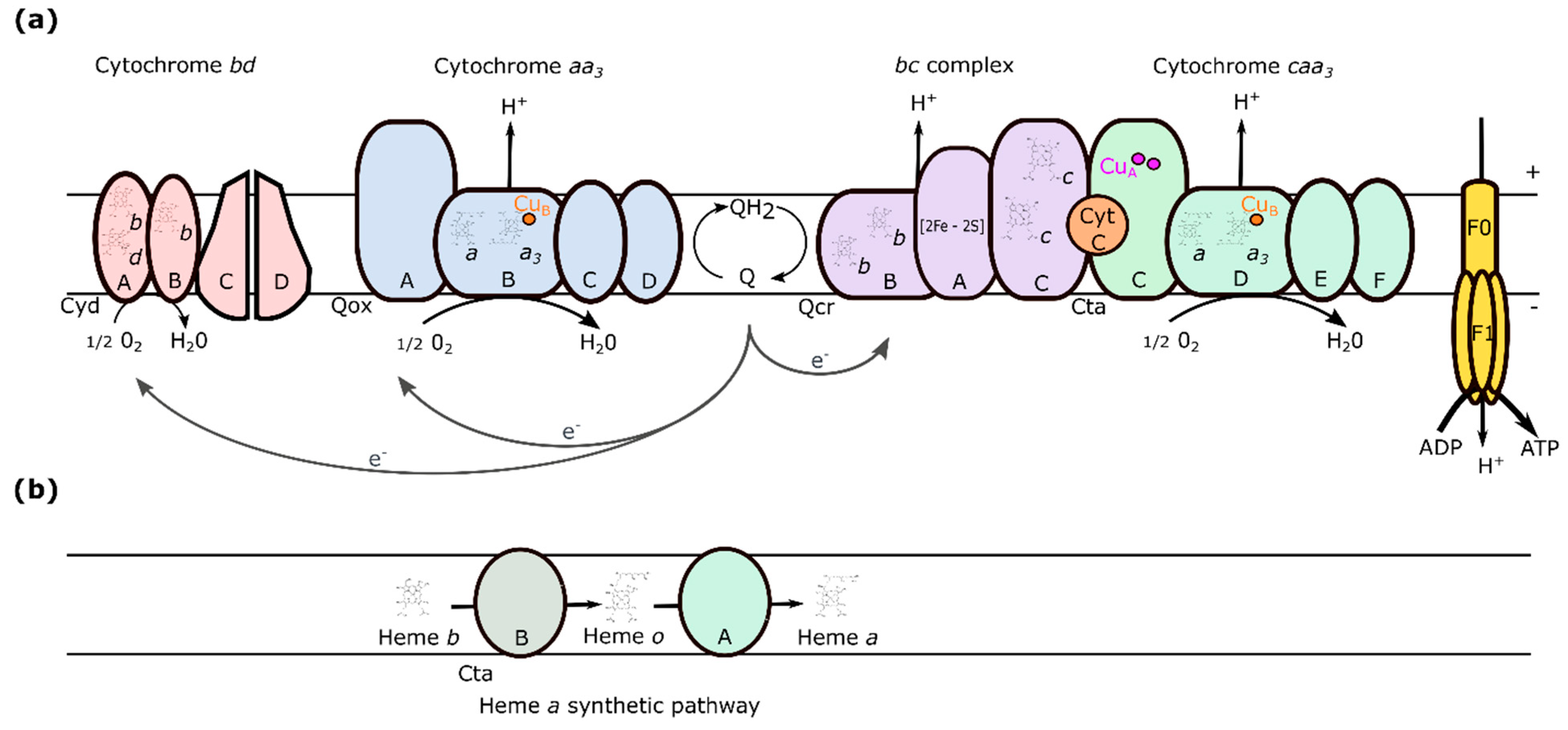
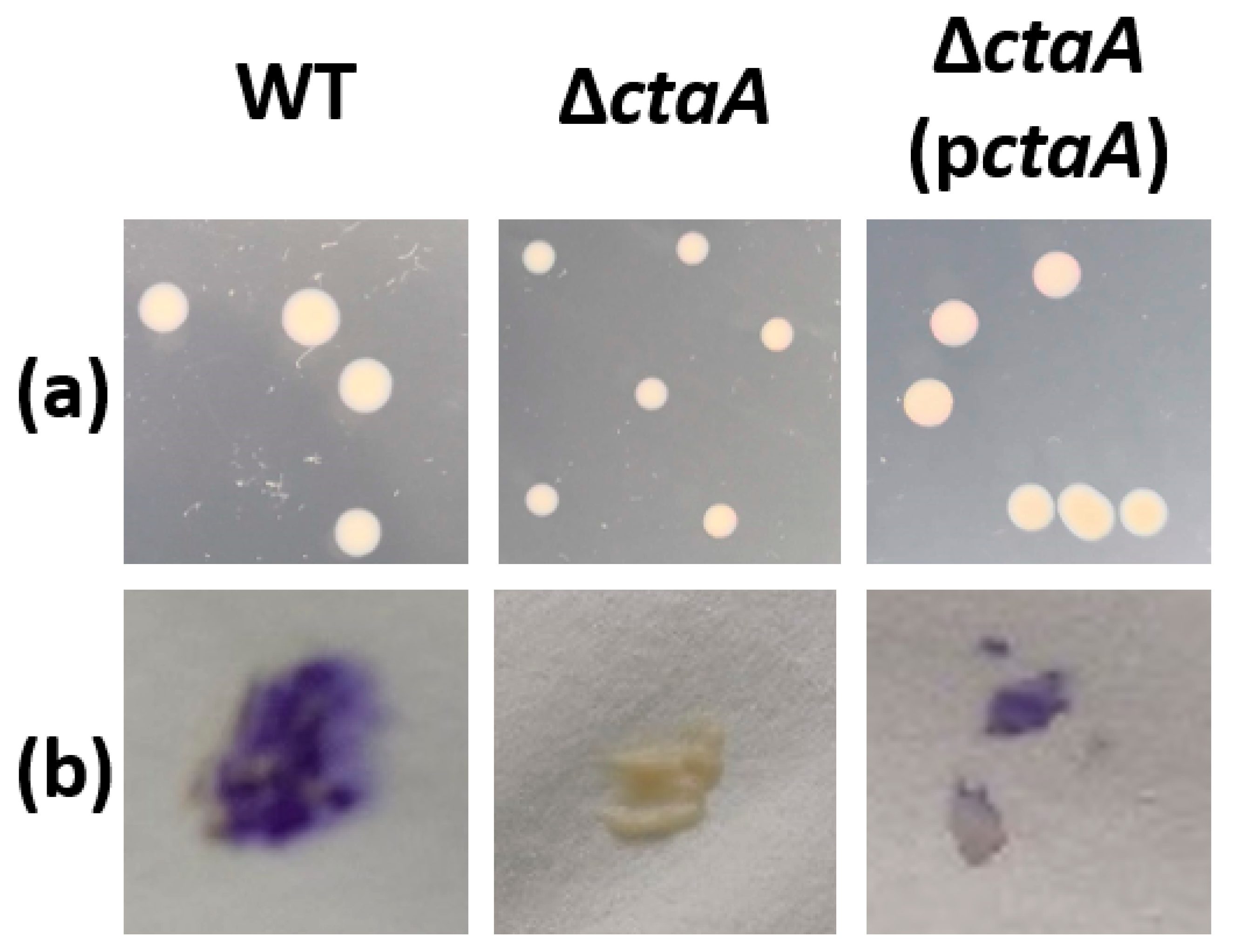
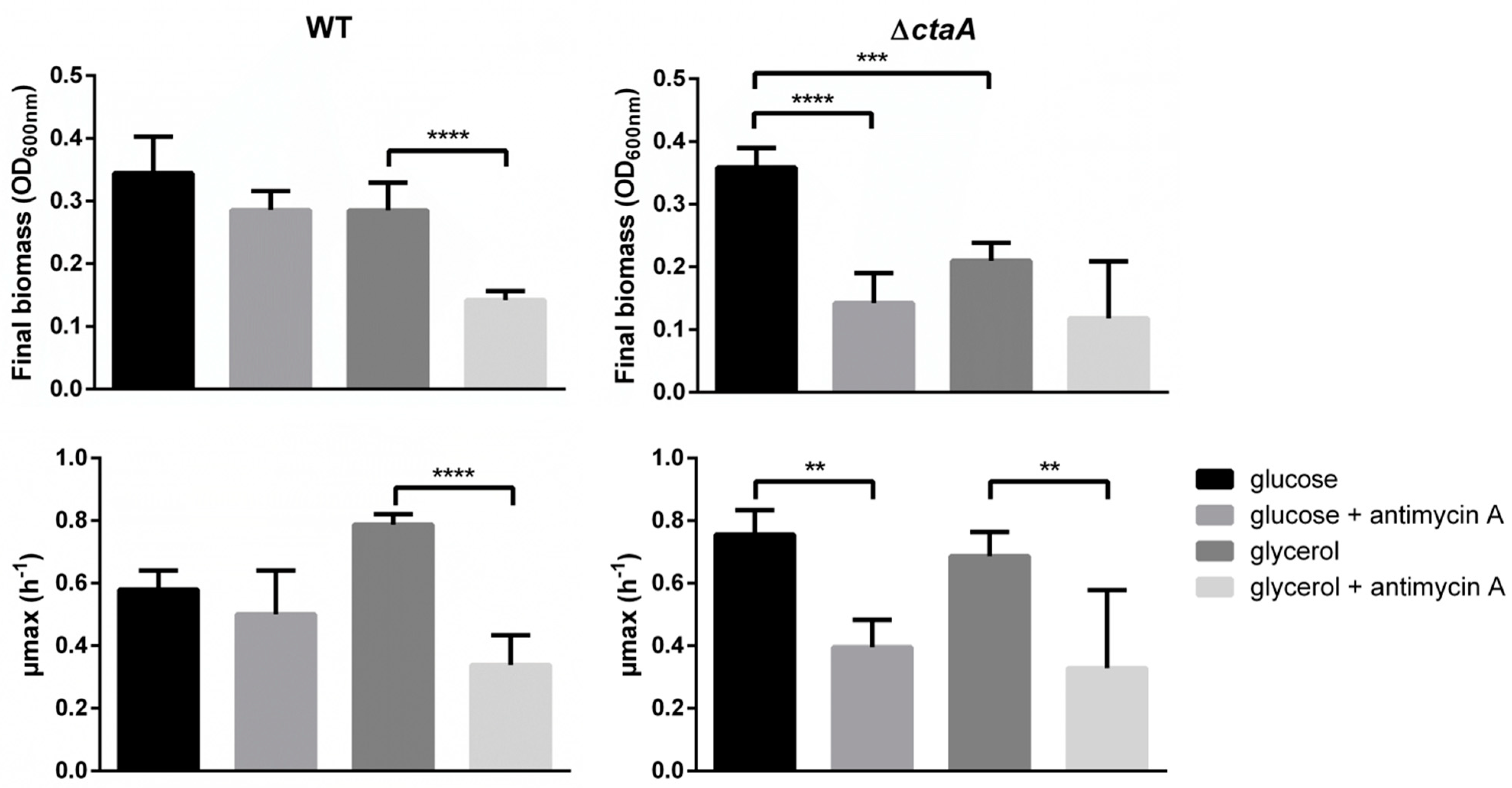
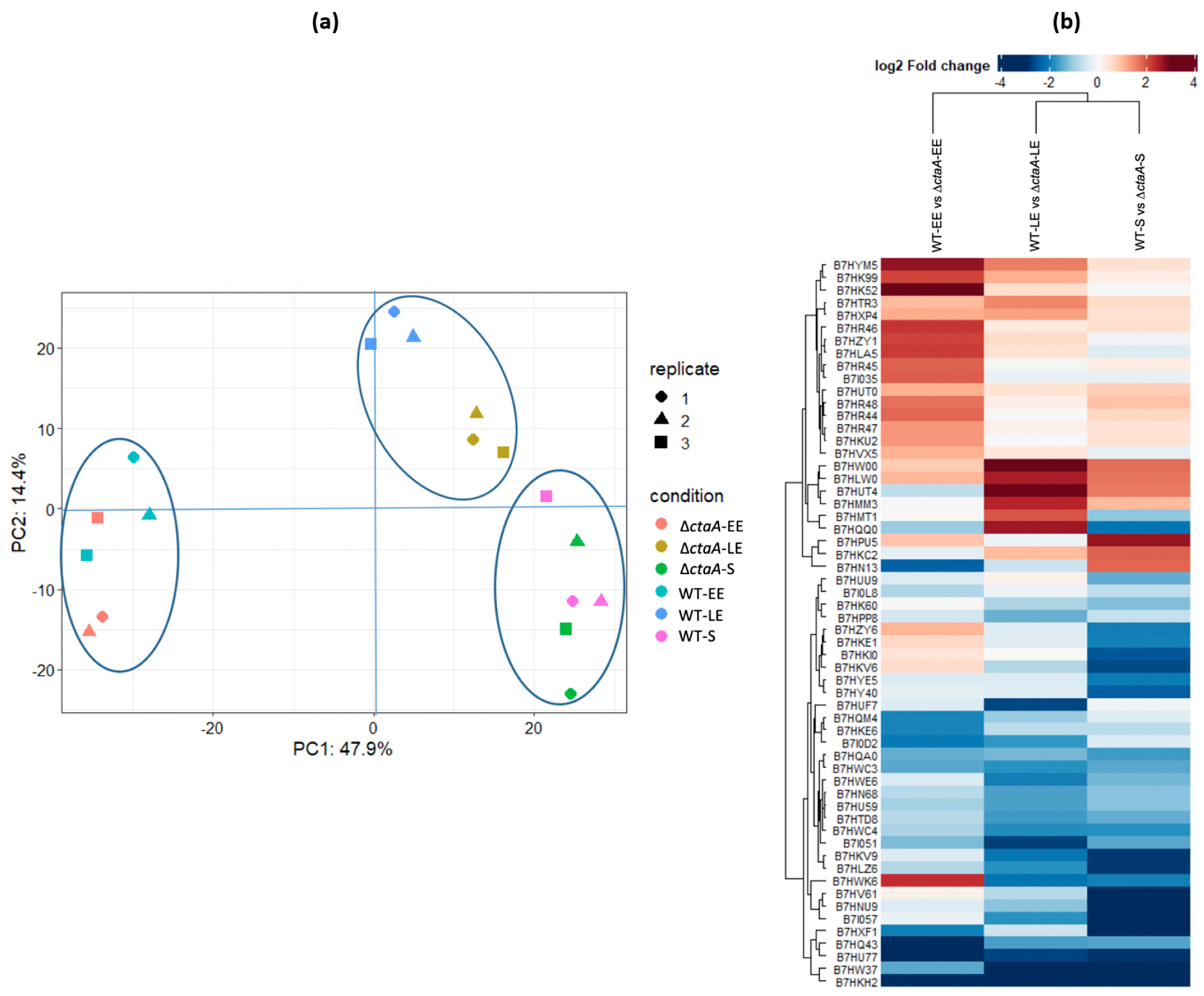

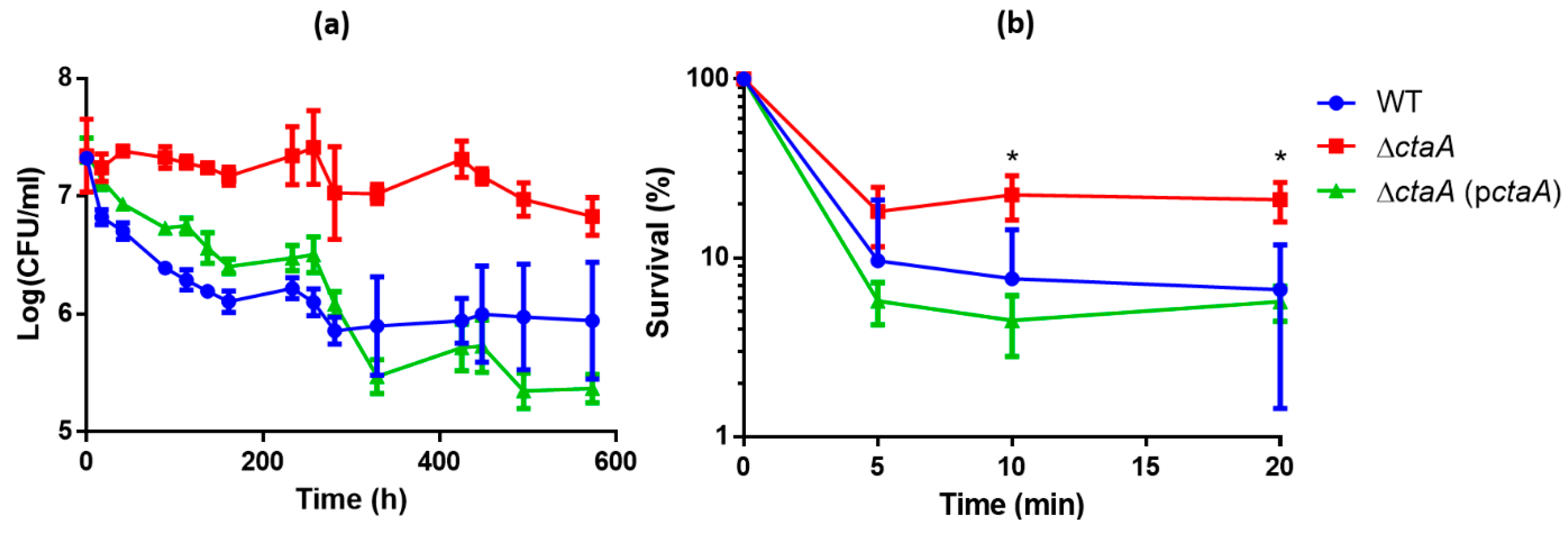
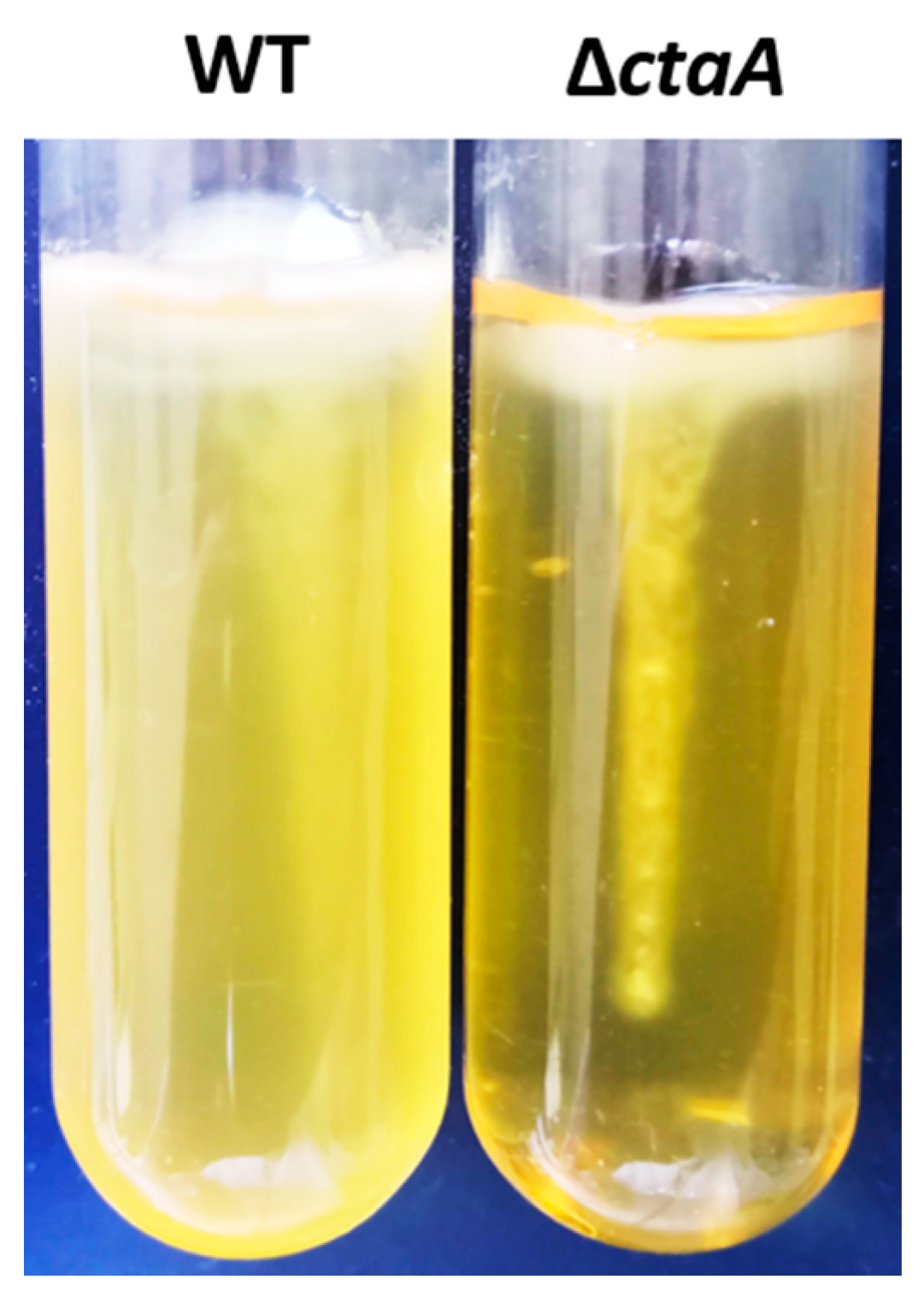
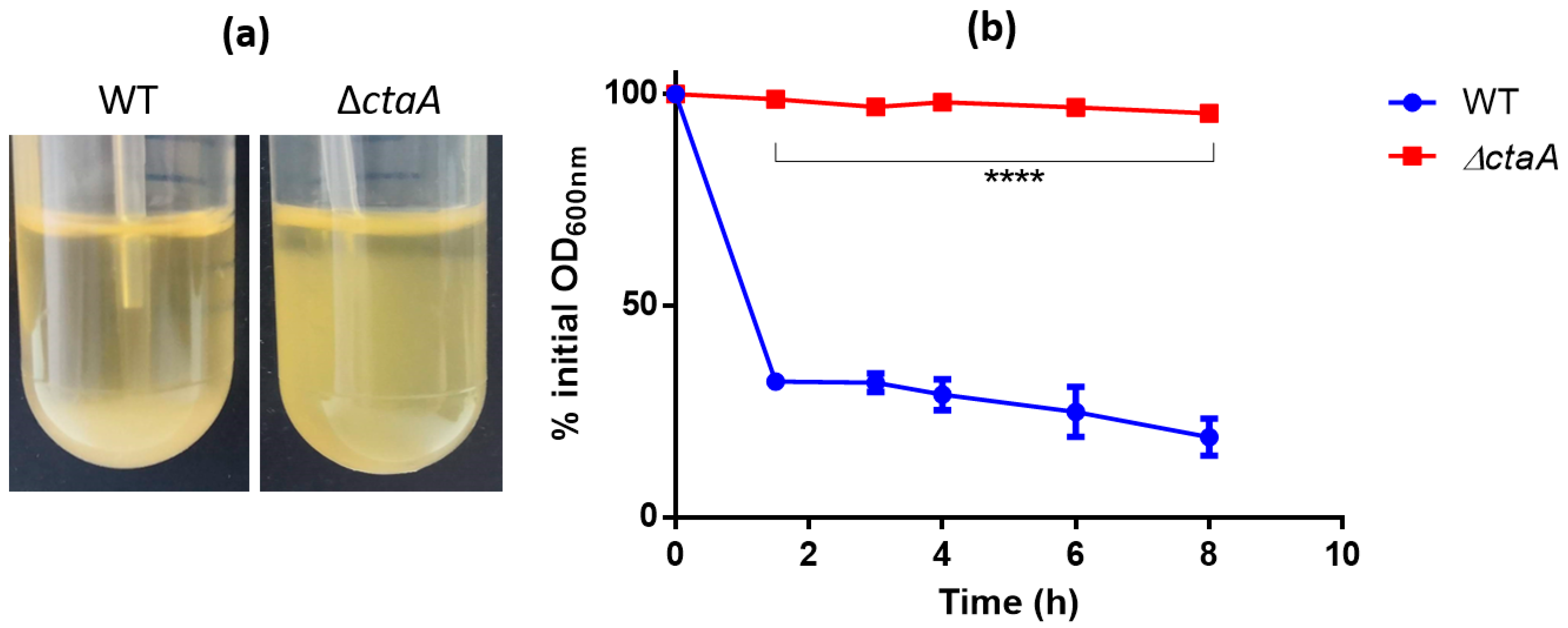
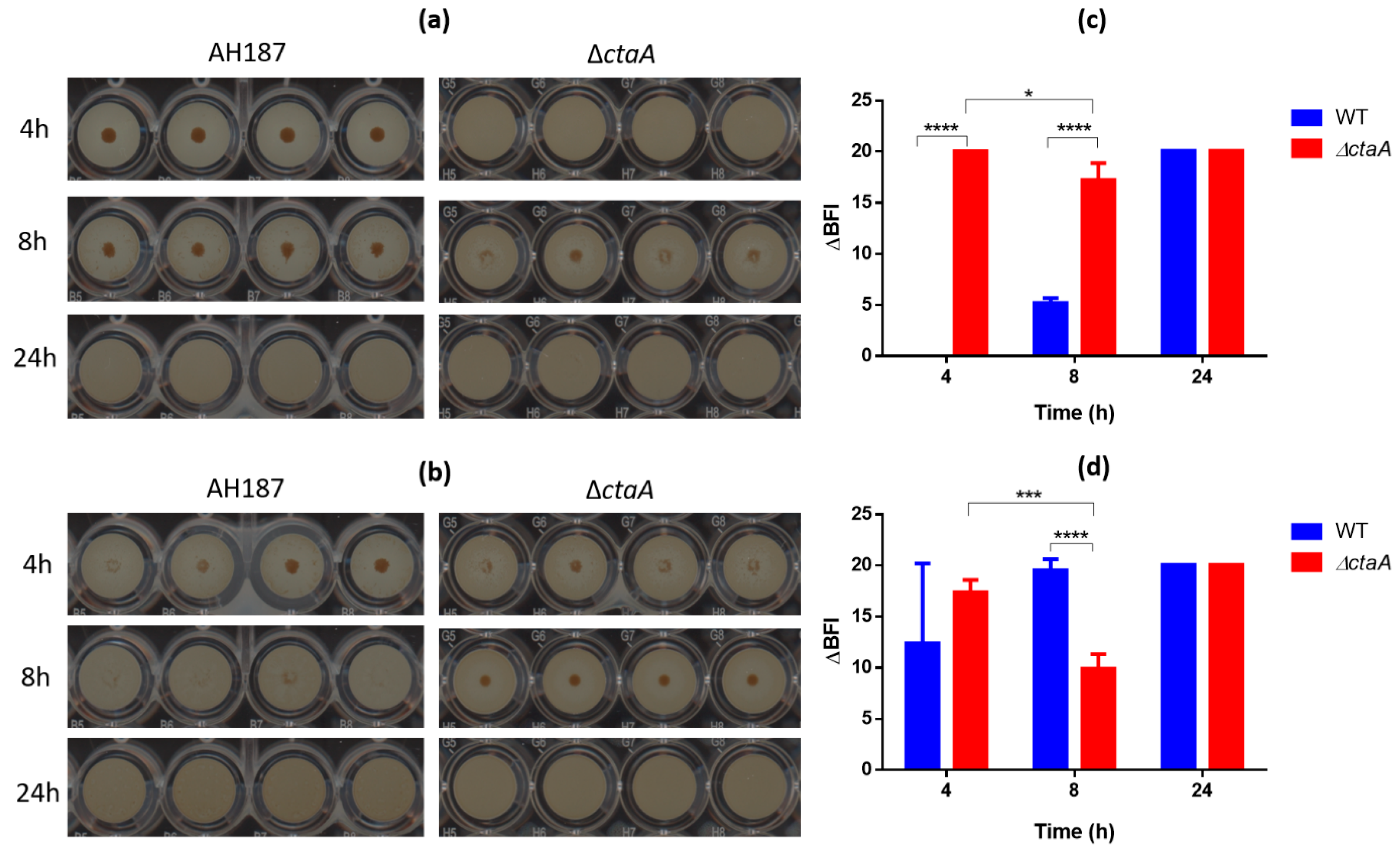
Publisher’s Note: MDPI stays neutral with regard to jurisdictional claims in published maps and institutional affiliations. |
© 2022 by the authors. Licensee MDPI, Basel, Switzerland. This article is an open access article distributed under the terms and conditions of the Creative Commons Attribution (CC BY) license (https://creativecommons.org/licenses/by/4.0/).
Share and Cite
Chateau, A.; Alpha-Bazin, B.; Armengaud, J.; Duport, C. Heme A Synthase Deficiency Affects the Ability of Bacillus cereus to Adapt to a Nutrient-Limited Environment. Int. J. Mol. Sci. 2022, 23, 1033. https://doi.org/10.3390/ijms23031033
Chateau A, Alpha-Bazin B, Armengaud J, Duport C. Heme A Synthase Deficiency Affects the Ability of Bacillus cereus to Adapt to a Nutrient-Limited Environment. International Journal of Molecular Sciences. 2022; 23(3):1033. https://doi.org/10.3390/ijms23031033
Chicago/Turabian StyleChateau, Alice, Béatrice Alpha-Bazin, Jean Armengaud, and Catherine Duport. 2022. "Heme A Synthase Deficiency Affects the Ability of Bacillus cereus to Adapt to a Nutrient-Limited Environment" International Journal of Molecular Sciences 23, no. 3: 1033. https://doi.org/10.3390/ijms23031033
APA StyleChateau, A., Alpha-Bazin, B., Armengaud, J., & Duport, C. (2022). Heme A Synthase Deficiency Affects the Ability of Bacillus cereus to Adapt to a Nutrient-Limited Environment. International Journal of Molecular Sciences, 23(3), 1033. https://doi.org/10.3390/ijms23031033






